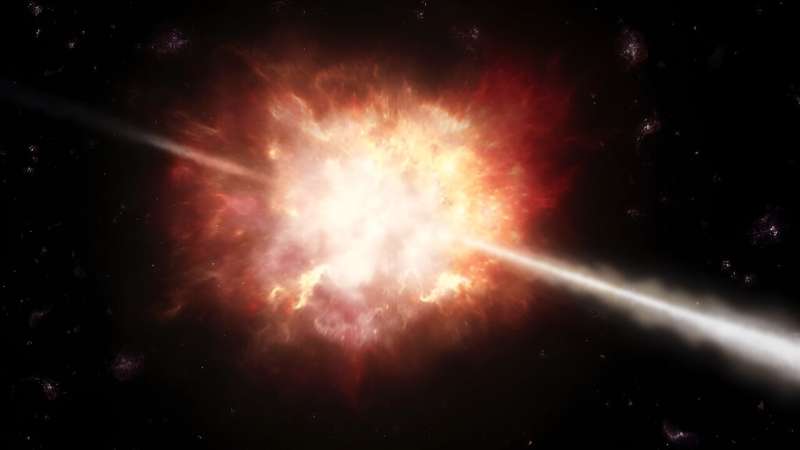This article has been reviewed according to Science X's editorial process and policies. Editors have highlighted the following attributes while ensuring the content's credibility:
fact-checked
peer-reviewed publication
trusted source
proofread
What's the link between gamma ray bursts and supernovae? It might be binary stars

Gamma-ray bursts (GRBs) are some of the most violent events in the universe. Some have a power output equivalent to all of the other stars in the observable universe, at least in the spectrum of gamma rays. But we know very little about them. A new paper published in The Astrophysical Journal from researchers on an interdisciplinary team from seven countries puts forth a new theory about how at least one type of GRB happens—when a binary of two specific types of stars collapses and forms a black hole.
That sounds relatively simple, but the actual mechanism for such a creation is not. It's best to start with the basics. There are commonly thought to be two types of GRBs—a "short" one, which lasts a few seconds, and a "long" one, which can last up to a few minutes. Short GRBs are commonly thought to be created by the collision between two massive objectives, such as black holes or neutron stars. However, long GRBs have been thought to be caused by the collapse of absolutely massive stars that hold more than 30 times the mass of our sun.
Stars that collapse with that weight create a type of event known as a hypernova—a type of massively powerful supernova that signifies the creation of a new black hole. Typically, these are thought of as happening simply when the star collapses. However, the research group, led by first author Yerlan Aimuratov of the Fesenkov Astrophysical Institute in Kazakhstan, thinks that it's not a single star collapsing that causes this but a pair of them.
In particular, they think these hypernovae that drive the creation of long GRBs are caused by a binary system composed of a Carbon-oxygen (CO) star and a neutron star (NS). When the core of the CO star begins to collapse, it triggers both a hypernova and the creation of a newborn neutron star. So now the binary system is itself composed of two neutron stars.
However, a large chunk of material ejected from the newly formed NS as part of the hypernova would then be captured by its companion binary neutron star. That addition of material can tip the star's balance into being too large and therefore cause it too to collapse. When it does so, it changes into a black hole, emitting the radiation that we see as part of a gamma-ray burst.
The authors go into plenty of detail about nuances of this process, including details about the impact of the rotational period of the binary system, and provide an exceptionally detailed background on the work that has led up to this theory, going all the way back to Newton's Principia Mathematica.
They also laud some of the telescopes that allowed them to look at some GRBs that allowed them to test their theory, notably the BeppoSAX satelliteas launched almost 30 years ago. However, NASA's SWIFT telescope and the Lick observatory found two GRBs that the team used as practical evidence supporting their theory. GRB090618 and GRB090423 both had hallmarks of being created by binary star systems and seemed to provide at least some evidence to support the theory.
However, there will likely still be a debate in the astrophysics community about what exactly causes these most destructive of phenomena. And that question is made all the more pressing because it could happen in our neighborhood one day—and that explosion might be a threat to all life on Earth. So it would be best if we were able to predict any system, whether it be binary or solitary, where such an event might happen close to us, and this paper takes us one more step down that path of understanding.
More information: Y. Aimuratov et al, GRB-SN Association within the Binary-driven Hypernova Model, The Astrophysical Journal (2023). DOI: 10.3847/1538-4357/ace721
Journal information: Astrophysical Journal
Provided by Universe Today





















